Retail Management: Department Stores & Discount Stores Evolution
VerifiedAdded on 2023/06/07
|8
|2667
|161
Essay
AI Summary
This essay examines the changing landscape of department stores and discount stores in the United States. It defines both types of retail establishments, highlighting the differences in their business models and pricing strategies. The essay traces the evolution of department stores from their prominence in the 1800s to the challenges they face today due to the rise of discount stores and online shopping. It discusses strategies retailers are employing to adapt to the digital age, including leveraging technology for personalized customer experiences, optimizing supply chains, and diversifying product offerings through scrambled and digital merchandising. The essay concludes that while technology will continue to transform the retail sector, the importance of customer service and a balance between online and offline experiences will remain crucial for success. Mobile commerce and innovative retail concepts are expected to further shape the future of retail.
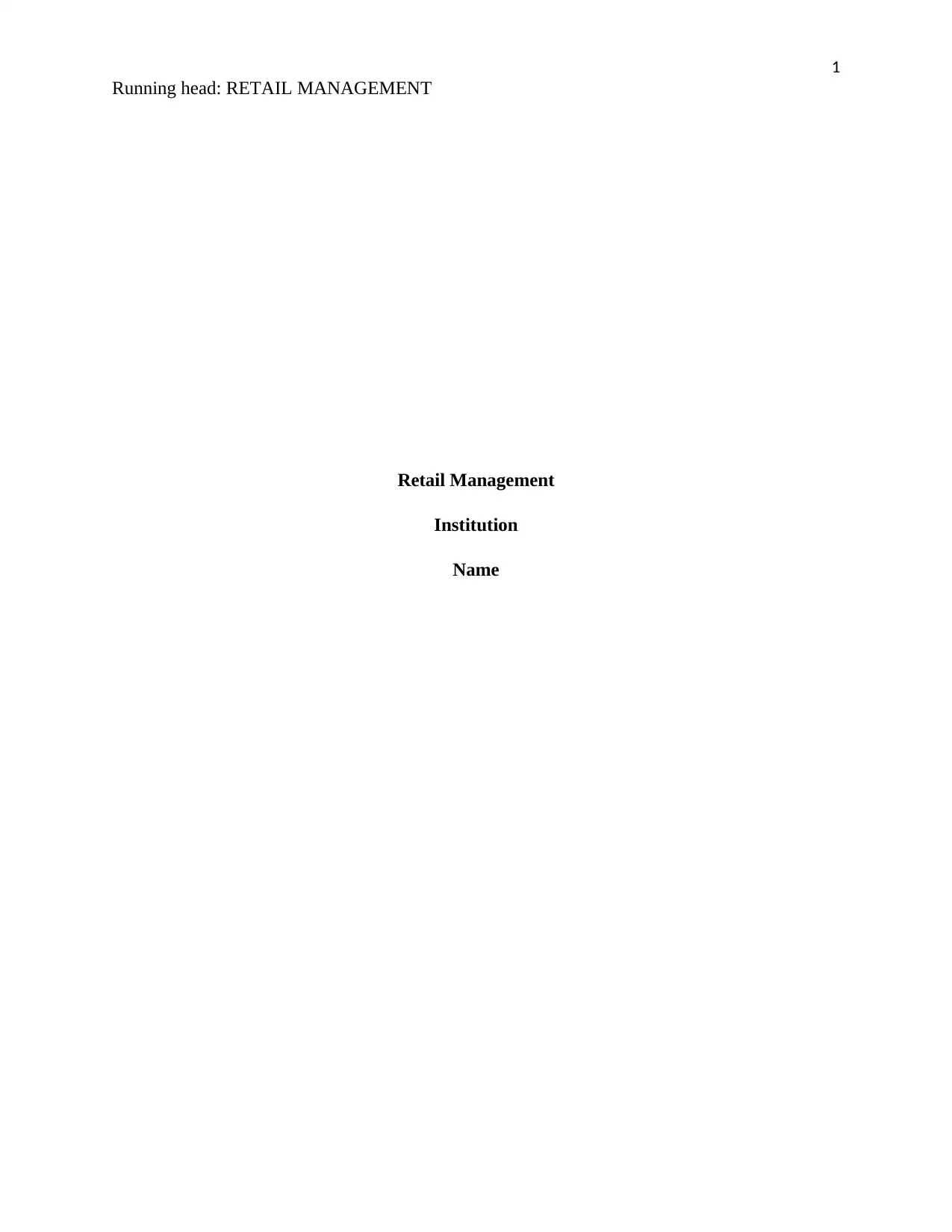
1
Running head: RETAIL MANAGEMENT
Retail Management
Institution
Name
Running head: RETAIL MANAGEMENT
Retail Management
Institution
Name
Paraphrase This Document
Need a fresh take? Get an instant paraphrase of this document with our AI Paraphraser
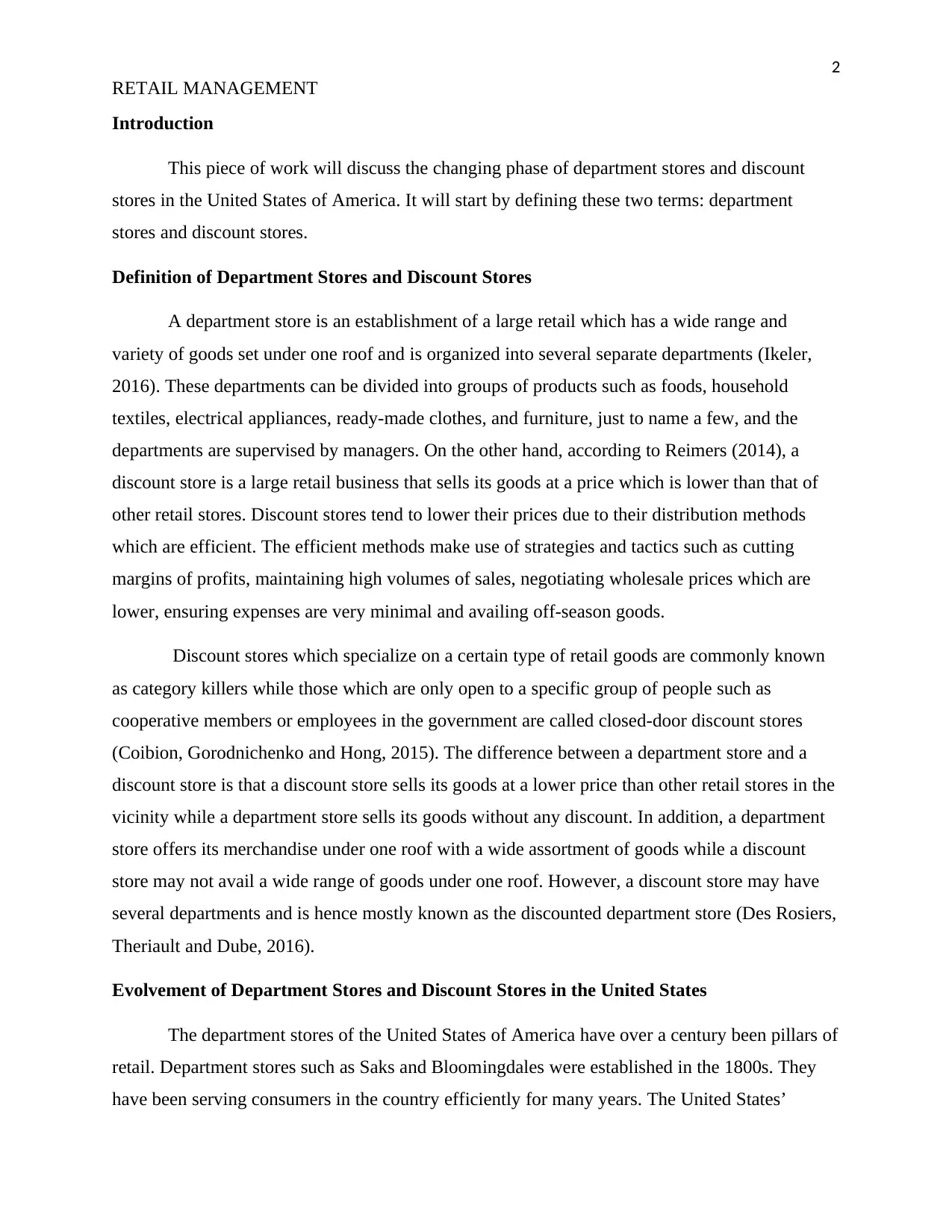
2
RETAIL MANAGEMENT
Introduction
This piece of work will discuss the changing phase of department stores and discount
stores in the United States of America. It will start by defining these two terms: department
stores and discount stores.
Definition of Department Stores and Discount Stores
A department store is an establishment of a large retail which has a wide range and
variety of goods set under one roof and is organized into several separate departments (Ikeler,
2016). These departments can be divided into groups of products such as foods, household
textiles, electrical appliances, ready-made clothes, and furniture, just to name a few, and the
departments are supervised by managers. On the other hand, according to Reimers (2014), a
discount store is a large retail business that sells its goods at a price which is lower than that of
other retail stores. Discount stores tend to lower their prices due to their distribution methods
which are efficient. The efficient methods make use of strategies and tactics such as cutting
margins of profits, maintaining high volumes of sales, negotiating wholesale prices which are
lower, ensuring expenses are very minimal and availing off-season goods.
Discount stores which specialize on a certain type of retail goods are commonly known
as category killers while those which are only open to a specific group of people such as
cooperative members or employees in the government are called closed-door discount stores
(Coibion, Gorodnichenko and Hong, 2015). The difference between a department store and a
discount store is that a discount store sells its goods at a lower price than other retail stores in the
vicinity while a department store sells its goods without any discount. In addition, a department
store offers its merchandise under one roof with a wide assortment of goods while a discount
store may not avail a wide range of goods under one roof. However, a discount store may have
several departments and is hence mostly known as the discounted department store (Des Rosiers,
Theriault and Dube, 2016).
Evolvement of Department Stores and Discount Stores in the United States
The department stores of the United States of America have over a century been pillars of
retail. Department stores such as Saks and Bloomingdales were established in the 1800s. They
have been serving consumers in the country efficiently for many years. The United States’
RETAIL MANAGEMENT
Introduction
This piece of work will discuss the changing phase of department stores and discount
stores in the United States of America. It will start by defining these two terms: department
stores and discount stores.
Definition of Department Stores and Discount Stores
A department store is an establishment of a large retail which has a wide range and
variety of goods set under one roof and is organized into several separate departments (Ikeler,
2016). These departments can be divided into groups of products such as foods, household
textiles, electrical appliances, ready-made clothes, and furniture, just to name a few, and the
departments are supervised by managers. On the other hand, according to Reimers (2014), a
discount store is a large retail business that sells its goods at a price which is lower than that of
other retail stores. Discount stores tend to lower their prices due to their distribution methods
which are efficient. The efficient methods make use of strategies and tactics such as cutting
margins of profits, maintaining high volumes of sales, negotiating wholesale prices which are
lower, ensuring expenses are very minimal and availing off-season goods.
Discount stores which specialize on a certain type of retail goods are commonly known
as category killers while those which are only open to a specific group of people such as
cooperative members or employees in the government are called closed-door discount stores
(Coibion, Gorodnichenko and Hong, 2015). The difference between a department store and a
discount store is that a discount store sells its goods at a lower price than other retail stores in the
vicinity while a department store sells its goods without any discount. In addition, a department
store offers its merchandise under one roof with a wide assortment of goods while a discount
store may not avail a wide range of goods under one roof. However, a discount store may have
several departments and is hence mostly known as the discounted department store (Des Rosiers,
Theriault and Dube, 2016).
Evolvement of Department Stores and Discount Stores in the United States
The department stores of the United States of America have over a century been pillars of
retail. Department stores such as Saks and Bloomingdales were established in the 1800s. They
have been serving consumers in the country efficiently for many years. The United States’
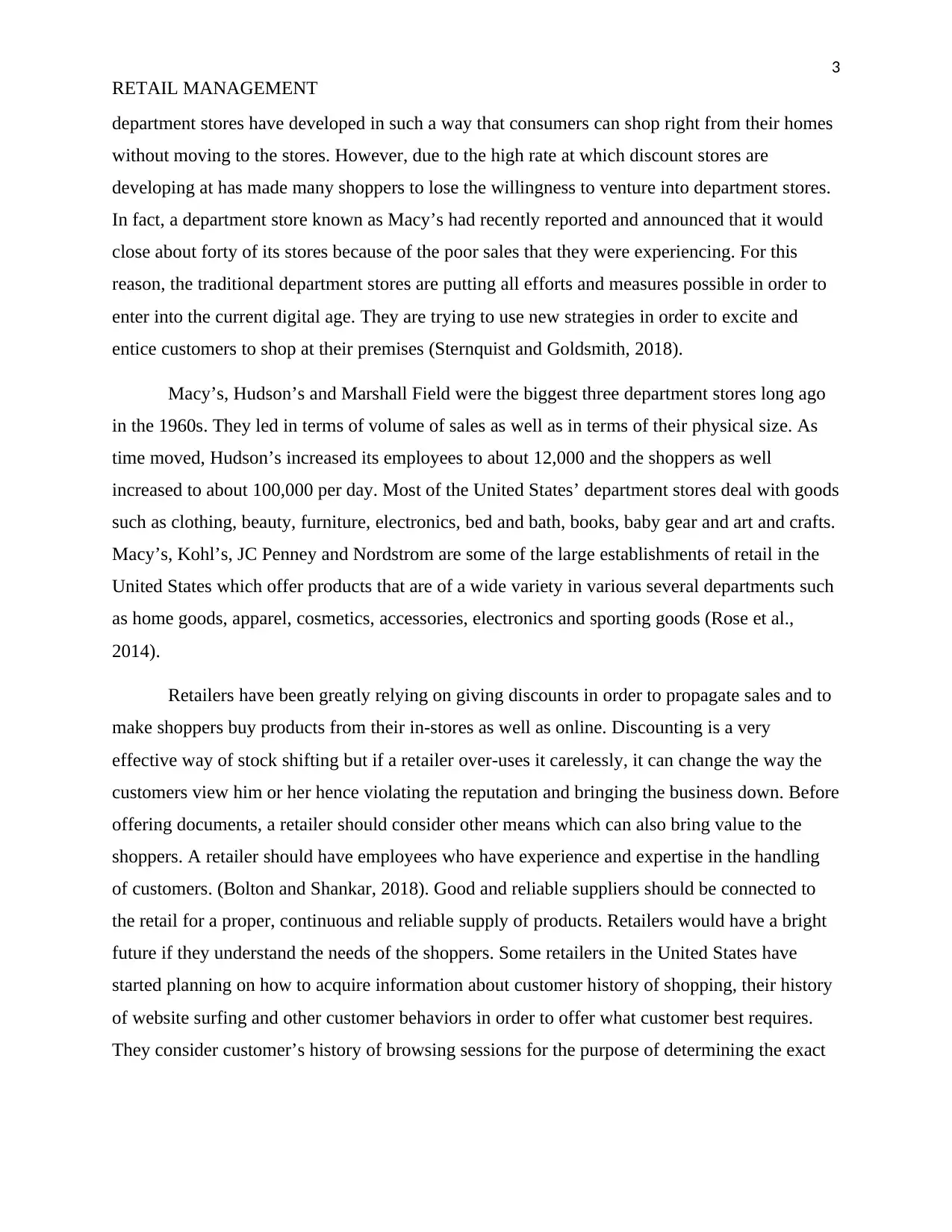
3
RETAIL MANAGEMENT
department stores have developed in such a way that consumers can shop right from their homes
without moving to the stores. However, due to the high rate at which discount stores are
developing at has made many shoppers to lose the willingness to venture into department stores.
In fact, a department store known as Macy’s had recently reported and announced that it would
close about forty of its stores because of the poor sales that they were experiencing. For this
reason, the traditional department stores are putting all efforts and measures possible in order to
enter into the current digital age. They are trying to use new strategies in order to excite and
entice customers to shop at their premises (Sternquist and Goldsmith, 2018).
Macy’s, Hudson’s and Marshall Field were the biggest three department stores long ago
in the 1960s. They led in terms of volume of sales as well as in terms of their physical size. As
time moved, Hudson’s increased its employees to about 12,000 and the shoppers as well
increased to about 100,000 per day. Most of the United States’ department stores deal with goods
such as clothing, beauty, furniture, electronics, bed and bath, books, baby gear and art and crafts.
Macy’s, Kohl’s, JC Penney and Nordstrom are some of the large establishments of retail in the
United States which offer products that are of a wide variety in various several departments such
as home goods, apparel, cosmetics, accessories, electronics and sporting goods (Rose et al.,
2014).
Retailers have been greatly relying on giving discounts in order to propagate sales and to
make shoppers buy products from their in-stores as well as online. Discounting is a very
effective way of stock shifting but if a retailer over-uses it carelessly, it can change the way the
customers view him or her hence violating the reputation and bringing the business down. Before
offering documents, a retailer should consider other means which can also bring value to the
shoppers. A retailer should have employees who have experience and expertise in the handling
of customers. (Bolton and Shankar, 2018). Good and reliable suppliers should be connected to
the retail for a proper, continuous and reliable supply of products. Retailers would have a bright
future if they understand the needs of the shoppers. Some retailers in the United States have
started planning on how to acquire information about customer history of shopping, their history
of website surfing and other customer behaviors in order to offer what customer best requires.
They consider customer’s history of browsing sessions for the purpose of determining the exact
RETAIL MANAGEMENT
department stores have developed in such a way that consumers can shop right from their homes
without moving to the stores. However, due to the high rate at which discount stores are
developing at has made many shoppers to lose the willingness to venture into department stores.
In fact, a department store known as Macy’s had recently reported and announced that it would
close about forty of its stores because of the poor sales that they were experiencing. For this
reason, the traditional department stores are putting all efforts and measures possible in order to
enter into the current digital age. They are trying to use new strategies in order to excite and
entice customers to shop at their premises (Sternquist and Goldsmith, 2018).
Macy’s, Hudson’s and Marshall Field were the biggest three department stores long ago
in the 1960s. They led in terms of volume of sales as well as in terms of their physical size. As
time moved, Hudson’s increased its employees to about 12,000 and the shoppers as well
increased to about 100,000 per day. Most of the United States’ department stores deal with goods
such as clothing, beauty, furniture, electronics, bed and bath, books, baby gear and art and crafts.
Macy’s, Kohl’s, JC Penney and Nordstrom are some of the large establishments of retail in the
United States which offer products that are of a wide variety in various several departments such
as home goods, apparel, cosmetics, accessories, electronics and sporting goods (Rose et al.,
2014).
Retailers have been greatly relying on giving discounts in order to propagate sales and to
make shoppers buy products from their in-stores as well as online. Discounting is a very
effective way of stock shifting but if a retailer over-uses it carelessly, it can change the way the
customers view him or her hence violating the reputation and bringing the business down. Before
offering documents, a retailer should consider other means which can also bring value to the
shoppers. A retailer should have employees who have experience and expertise in the handling
of customers. (Bolton and Shankar, 2018). Good and reliable suppliers should be connected to
the retail for a proper, continuous and reliable supply of products. Retailers would have a bright
future if they understand the needs of the shoppers. Some retailers in the United States have
started planning on how to acquire information about customer history of shopping, their history
of website surfing and other customer behaviors in order to offer what customer best requires.
They consider customer’s history of browsing sessions for the purpose of determining the exact
⊘ This is a preview!⊘
Do you want full access?
Subscribe today to unlock all pages.

Trusted by 1+ million students worldwide
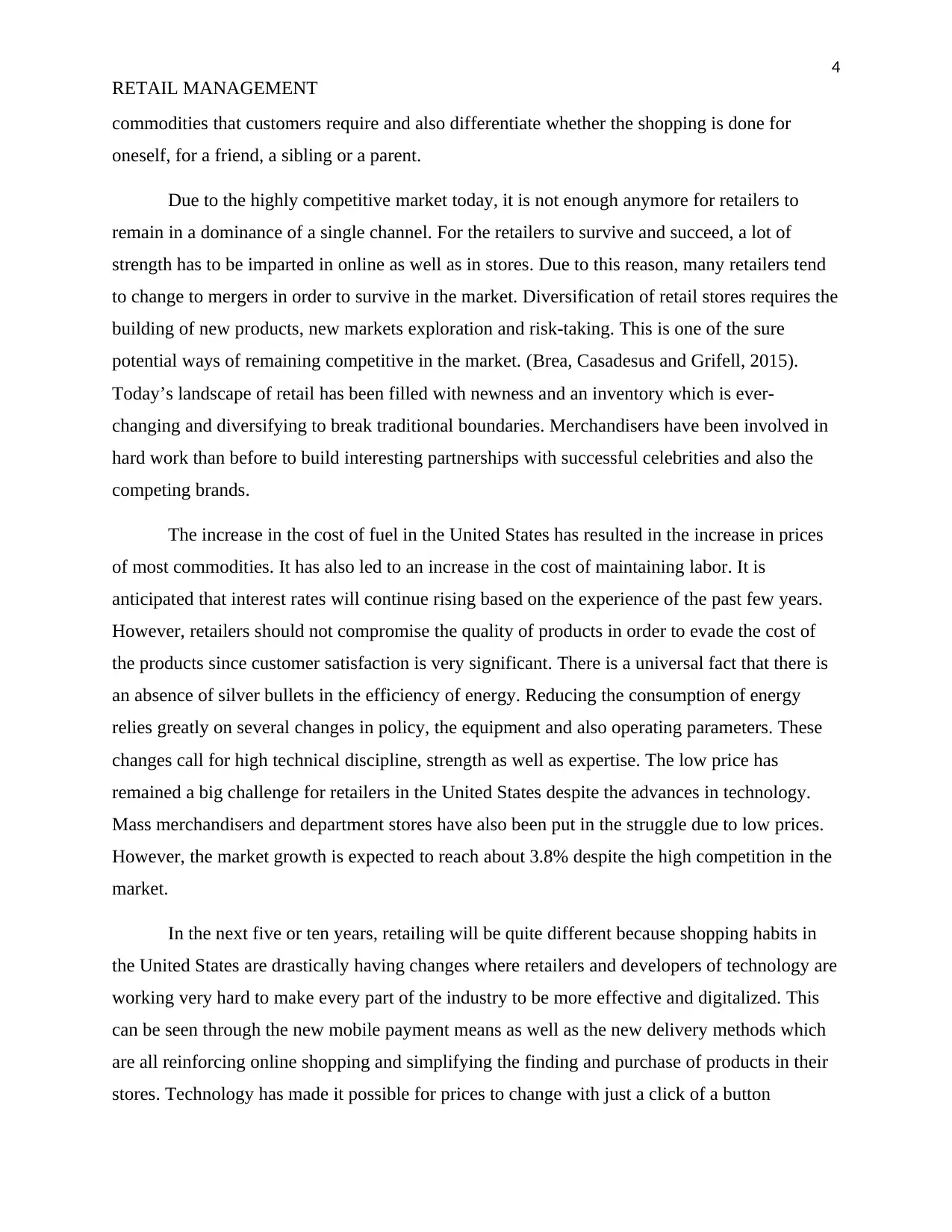
4
RETAIL MANAGEMENT
commodities that customers require and also differentiate whether the shopping is done for
oneself, for a friend, a sibling or a parent.
Due to the highly competitive market today, it is not enough anymore for retailers to
remain in a dominance of a single channel. For the retailers to survive and succeed, a lot of
strength has to be imparted in online as well as in stores. Due to this reason, many retailers tend
to change to mergers in order to survive in the market. Diversification of retail stores requires the
building of new products, new markets exploration and risk-taking. This is one of the sure
potential ways of remaining competitive in the market. (Brea, Casadesus and Grifell, 2015).
Today’s landscape of retail has been filled with newness and an inventory which is ever-
changing and diversifying to break traditional boundaries. Merchandisers have been involved in
hard work than before to build interesting partnerships with successful celebrities and also the
competing brands.
The increase in the cost of fuel in the United States has resulted in the increase in prices
of most commodities. It has also led to an increase in the cost of maintaining labor. It is
anticipated that interest rates will continue rising based on the experience of the past few years.
However, retailers should not compromise the quality of products in order to evade the cost of
the products since customer satisfaction is very significant. There is a universal fact that there is
an absence of silver bullets in the efficiency of energy. Reducing the consumption of energy
relies greatly on several changes in policy, the equipment and also operating parameters. These
changes call for high technical discipline, strength as well as expertise. The low price has
remained a big challenge for retailers in the United States despite the advances in technology.
Mass merchandisers and department stores have also been put in the struggle due to low prices.
However, the market growth is expected to reach about 3.8% despite the high competition in the
market.
In the next five or ten years, retailing will be quite different because shopping habits in
the United States are drastically having changes where retailers and developers of technology are
working very hard to make every part of the industry to be more effective and digitalized. This
can be seen through the new mobile payment means as well as the new delivery methods which
are all reinforcing online shopping and simplifying the finding and purchase of products in their
stores. Technology has made it possible for prices to change with just a click of a button
RETAIL MANAGEMENT
commodities that customers require and also differentiate whether the shopping is done for
oneself, for a friend, a sibling or a parent.
Due to the highly competitive market today, it is not enough anymore for retailers to
remain in a dominance of a single channel. For the retailers to survive and succeed, a lot of
strength has to be imparted in online as well as in stores. Due to this reason, many retailers tend
to change to mergers in order to survive in the market. Diversification of retail stores requires the
building of new products, new markets exploration and risk-taking. This is one of the sure
potential ways of remaining competitive in the market. (Brea, Casadesus and Grifell, 2015).
Today’s landscape of retail has been filled with newness and an inventory which is ever-
changing and diversifying to break traditional boundaries. Merchandisers have been involved in
hard work than before to build interesting partnerships with successful celebrities and also the
competing brands.
The increase in the cost of fuel in the United States has resulted in the increase in prices
of most commodities. It has also led to an increase in the cost of maintaining labor. It is
anticipated that interest rates will continue rising based on the experience of the past few years.
However, retailers should not compromise the quality of products in order to evade the cost of
the products since customer satisfaction is very significant. There is a universal fact that there is
an absence of silver bullets in the efficiency of energy. Reducing the consumption of energy
relies greatly on several changes in policy, the equipment and also operating parameters. These
changes call for high technical discipline, strength as well as expertise. The low price has
remained a big challenge for retailers in the United States despite the advances in technology.
Mass merchandisers and department stores have also been put in the struggle due to low prices.
However, the market growth is expected to reach about 3.8% despite the high competition in the
market.
In the next five or ten years, retailing will be quite different because shopping habits in
the United States are drastically having changes where retailers and developers of technology are
working very hard to make every part of the industry to be more effective and digitalized. This
can be seen through the new mobile payment means as well as the new delivery methods which
are all reinforcing online shopping and simplifying the finding and purchase of products in their
stores. Technology has made it possible for prices to change with just a click of a button
Paraphrase This Document
Need a fresh take? Get an instant paraphrase of this document with our AI Paraphraser
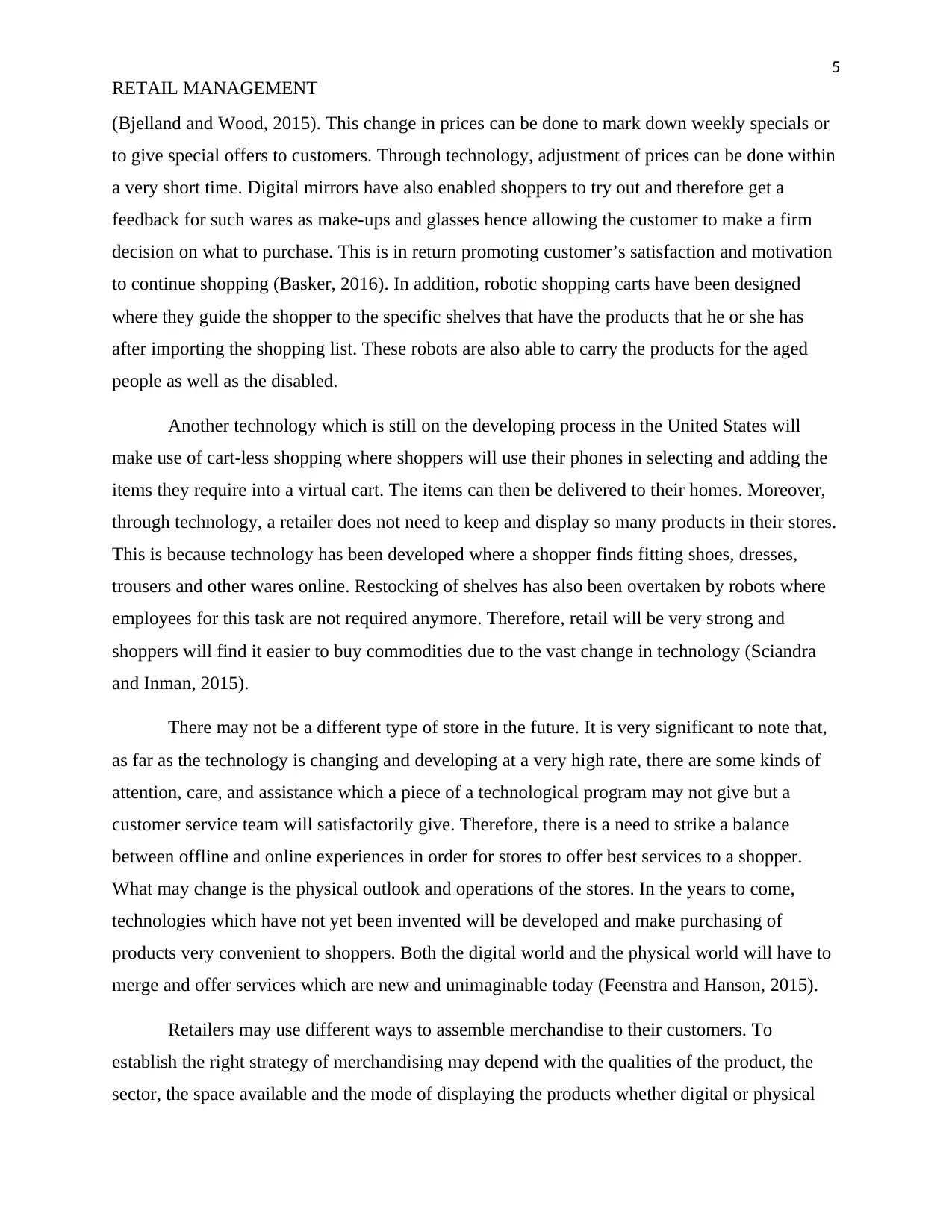
5
RETAIL MANAGEMENT
(Bjelland and Wood, 2015). This change in prices can be done to mark down weekly specials or
to give special offers to customers. Through technology, adjustment of prices can be done within
a very short time. Digital mirrors have also enabled shoppers to try out and therefore get a
feedback for such wares as make-ups and glasses hence allowing the customer to make a firm
decision on what to purchase. This is in return promoting customer’s satisfaction and motivation
to continue shopping (Basker, 2016). In addition, robotic shopping carts have been designed
where they guide the shopper to the specific shelves that have the products that he or she has
after importing the shopping list. These robots are also able to carry the products for the aged
people as well as the disabled.
Another technology which is still on the developing process in the United States will
make use of cart-less shopping where shoppers will use their phones in selecting and adding the
items they require into a virtual cart. The items can then be delivered to their homes. Moreover,
through technology, a retailer does not need to keep and display so many products in their stores.
This is because technology has been developed where a shopper finds fitting shoes, dresses,
trousers and other wares online. Restocking of shelves has also been overtaken by robots where
employees for this task are not required anymore. Therefore, retail will be very strong and
shoppers will find it easier to buy commodities due to the vast change in technology (Sciandra
and Inman, 2015).
There may not be a different type of store in the future. It is very significant to note that,
as far as the technology is changing and developing at a very high rate, there are some kinds of
attention, care, and assistance which a piece of a technological program may not give but a
customer service team will satisfactorily give. Therefore, there is a need to strike a balance
between offline and online experiences in order for stores to offer best services to a shopper.
What may change is the physical outlook and operations of the stores. In the years to come,
technologies which have not yet been invented will be developed and make purchasing of
products very convenient to shoppers. Both the digital world and the physical world will have to
merge and offer services which are new and unimaginable today (Feenstra and Hanson, 2015).
Retailers may use different ways to assemble merchandise to their customers. To
establish the right strategy of merchandising may depend with the qualities of the product, the
sector, the space available and the mode of displaying the products whether digital or physical
RETAIL MANAGEMENT
(Bjelland and Wood, 2015). This change in prices can be done to mark down weekly specials or
to give special offers to customers. Through technology, adjustment of prices can be done within
a very short time. Digital mirrors have also enabled shoppers to try out and therefore get a
feedback for such wares as make-ups and glasses hence allowing the customer to make a firm
decision on what to purchase. This is in return promoting customer’s satisfaction and motivation
to continue shopping (Basker, 2016). In addition, robotic shopping carts have been designed
where they guide the shopper to the specific shelves that have the products that he or she has
after importing the shopping list. These robots are also able to carry the products for the aged
people as well as the disabled.
Another technology which is still on the developing process in the United States will
make use of cart-less shopping where shoppers will use their phones in selecting and adding the
items they require into a virtual cart. The items can then be delivered to their homes. Moreover,
through technology, a retailer does not need to keep and display so many products in their stores.
This is because technology has been developed where a shopper finds fitting shoes, dresses,
trousers and other wares online. Restocking of shelves has also been overtaken by robots where
employees for this task are not required anymore. Therefore, retail will be very strong and
shoppers will find it easier to buy commodities due to the vast change in technology (Sciandra
and Inman, 2015).
There may not be a different type of store in the future. It is very significant to note that,
as far as the technology is changing and developing at a very high rate, there are some kinds of
attention, care, and assistance which a piece of a technological program may not give but a
customer service team will satisfactorily give. Therefore, there is a need to strike a balance
between offline and online experiences in order for stores to offer best services to a shopper.
What may change is the physical outlook and operations of the stores. In the years to come,
technologies which have not yet been invented will be developed and make purchasing of
products very convenient to shoppers. Both the digital world and the physical world will have to
merge and offer services which are new and unimaginable today (Feenstra and Hanson, 2015).
Retailers may use different ways to assemble merchandise to their customers. To
establish the right strategy of merchandising may depend with the qualities of the product, the
sector, the space available and the mode of displaying the products whether digital or physical

6
RETAIL MANAGEMENT
(Millhouse, Burleson and Meredith, 2017). Scrambled merchandising occurs when a retailer sells
scattered products which are unrelated and which may not relate to the original focus of the
store. For example, a customer may go to a drug store but can still buy other products such as
groceries from it (Breslow and Swafford, 2015). Digital merchandising is where promotional
activities aiming at selling products are done online. On contrary, retail merchandising involves
advertising and making sales of products physically at the vicinities of the store (Paolini, 2017).
Conclusion
In conclusion, the way retail stores used to operate in the traditional times is not the same way
they are operating presently, and move advancements and developments will continue being laid
down, making retailing to be better than today. There is a phenomenon known as mobile
commerce which has spread worldwide, where customers shop at their own homes or anywhere
regardless of where they are in the world. Since nature hates vacuum, there will always emerge
new concepts and new ideas will transform this sector of retail (Yadav, Sharma and Tarhini,
2016).
RETAIL MANAGEMENT
(Millhouse, Burleson and Meredith, 2017). Scrambled merchandising occurs when a retailer sells
scattered products which are unrelated and which may not relate to the original focus of the
store. For example, a customer may go to a drug store but can still buy other products such as
groceries from it (Breslow and Swafford, 2015). Digital merchandising is where promotional
activities aiming at selling products are done online. On contrary, retail merchandising involves
advertising and making sales of products physically at the vicinities of the store (Paolini, 2017).
Conclusion
In conclusion, the way retail stores used to operate in the traditional times is not the same way
they are operating presently, and move advancements and developments will continue being laid
down, making retailing to be better than today. There is a phenomenon known as mobile
commerce which has spread worldwide, where customers shop at their own homes or anywhere
regardless of where they are in the world. Since nature hates vacuum, there will always emerge
new concepts and new ideas will transform this sector of retail (Yadav, Sharma and Tarhini,
2016).
⊘ This is a preview!⊘
Do you want full access?
Subscribe today to unlock all pages.

Trusted by 1+ million students worldwide
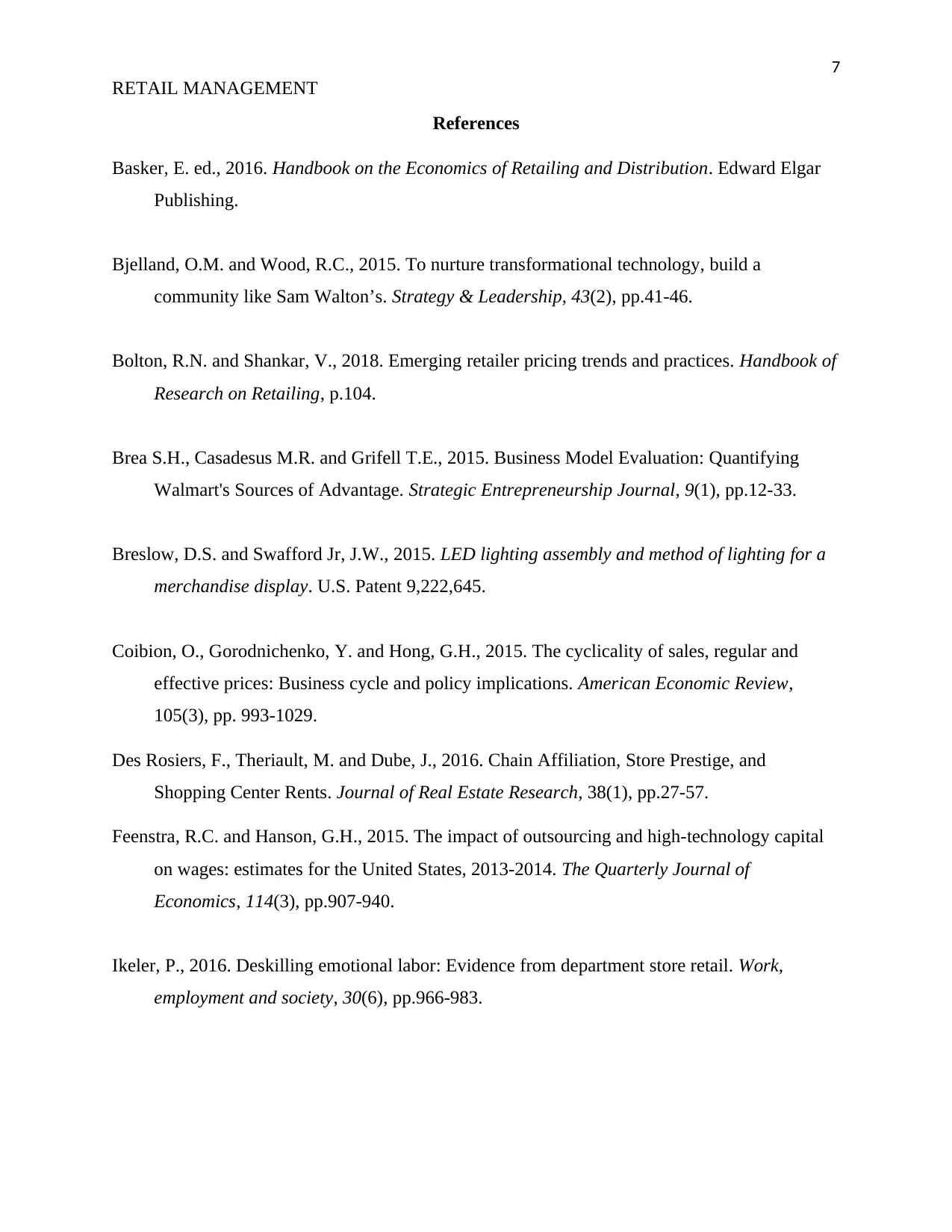
7
RETAIL MANAGEMENT
References
Basker, E. ed., 2016. Handbook on the Economics of Retailing and Distribution. Edward Elgar
Publishing.
Bjelland, O.M. and Wood, R.C., 2015. To nurture transformational technology, build a
community like Sam Walton’s. Strategy & Leadership, 43(2), pp.41-46.
Bolton, R.N. and Shankar, V., 2018. Emerging retailer pricing trends and practices. Handbook of
Research on Retailing, p.104.
Brea S.H., Casadesus M.R. and Grifell T.E., 2015. Business Model Evaluation: Quantifying
Walmart's Sources of Advantage. Strategic Entrepreneurship Journal, 9(1), pp.12-33.
Breslow, D.S. and Swafford Jr, J.W., 2015. LED lighting assembly and method of lighting for a
merchandise display. U.S. Patent 9,222,645.
Coibion, O., Gorodnichenko, Y. and Hong, G.H., 2015. The cyclicality of sales, regular and
effective prices: Business cycle and policy implications. American Economic Review,
105(3), pp. 993-1029.
Des Rosiers, F., Theriault, M. and Dube, J., 2016. Chain Affiliation, Store Prestige, and
Shopping Center Rents. Journal of Real Estate Research, 38(1), pp.27-57.
Feenstra, R.C. and Hanson, G.H., 2015. The impact of outsourcing and high-technology capital
on wages: estimates for the United States, 2013-2014. The Quarterly Journal of
Economics, 114(3), pp.907-940.
Ikeler, P., 2016. Deskilling emotional labor: Evidence from department store retail. Work,
employment and society, 30(6), pp.966-983.
RETAIL MANAGEMENT
References
Basker, E. ed., 2016. Handbook on the Economics of Retailing and Distribution. Edward Elgar
Publishing.
Bjelland, O.M. and Wood, R.C., 2015. To nurture transformational technology, build a
community like Sam Walton’s. Strategy & Leadership, 43(2), pp.41-46.
Bolton, R.N. and Shankar, V., 2018. Emerging retailer pricing trends and practices. Handbook of
Research on Retailing, p.104.
Brea S.H., Casadesus M.R. and Grifell T.E., 2015. Business Model Evaluation: Quantifying
Walmart's Sources of Advantage. Strategic Entrepreneurship Journal, 9(1), pp.12-33.
Breslow, D.S. and Swafford Jr, J.W., 2015. LED lighting assembly and method of lighting for a
merchandise display. U.S. Patent 9,222,645.
Coibion, O., Gorodnichenko, Y. and Hong, G.H., 2015. The cyclicality of sales, regular and
effective prices: Business cycle and policy implications. American Economic Review,
105(3), pp. 993-1029.
Des Rosiers, F., Theriault, M. and Dube, J., 2016. Chain Affiliation, Store Prestige, and
Shopping Center Rents. Journal of Real Estate Research, 38(1), pp.27-57.
Feenstra, R.C. and Hanson, G.H., 2015. The impact of outsourcing and high-technology capital
on wages: estimates for the United States, 2013-2014. The Quarterly Journal of
Economics, 114(3), pp.907-940.
Ikeler, P., 2016. Deskilling emotional labor: Evidence from department store retail. Work,
employment and society, 30(6), pp.966-983.
Paraphrase This Document
Need a fresh take? Get an instant paraphrase of this document with our AI Paraphraser
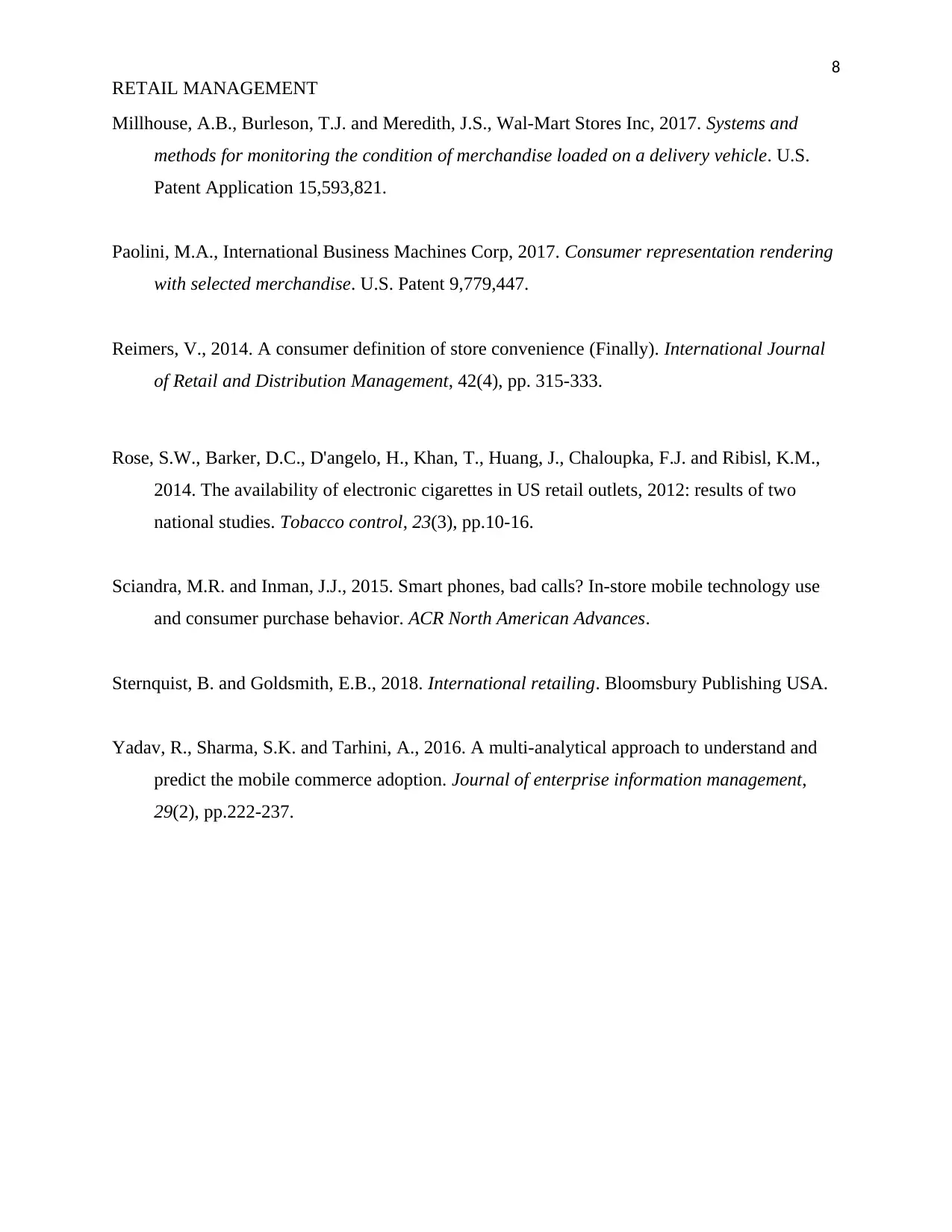
8
RETAIL MANAGEMENT
Millhouse, A.B., Burleson, T.J. and Meredith, J.S., Wal-Mart Stores Inc, 2017. Systems and
methods for monitoring the condition of merchandise loaded on a delivery vehicle. U.S.
Patent Application 15,593,821.
Paolini, M.A., International Business Machines Corp, 2017. Consumer representation rendering
with selected merchandise. U.S. Patent 9,779,447.
Reimers, V., 2014. A consumer definition of store convenience (Finally). International Journal
of Retail and Distribution Management, 42(4), pp. 315-333.
Rose, S.W., Barker, D.C., D'angelo, H., Khan, T., Huang, J., Chaloupka, F.J. and Ribisl, K.M.,
2014. The availability of electronic cigarettes in US retail outlets, 2012: results of two
national studies. Tobacco control, 23(3), pp.10-16.
Sciandra, M.R. and Inman, J.J., 2015. Smart phones, bad calls? In-store mobile technology use
and consumer purchase behavior. ACR North American Advances.
Sternquist, B. and Goldsmith, E.B., 2018. International retailing. Bloomsbury Publishing USA.
Yadav, R., Sharma, S.K. and Tarhini, A., 2016. A multi-analytical approach to understand and
predict the mobile commerce adoption. Journal of enterprise information management,
29(2), pp.222-237.
RETAIL MANAGEMENT
Millhouse, A.B., Burleson, T.J. and Meredith, J.S., Wal-Mart Stores Inc, 2017. Systems and
methods for monitoring the condition of merchandise loaded on a delivery vehicle. U.S.
Patent Application 15,593,821.
Paolini, M.A., International Business Machines Corp, 2017. Consumer representation rendering
with selected merchandise. U.S. Patent 9,779,447.
Reimers, V., 2014. A consumer definition of store convenience (Finally). International Journal
of Retail and Distribution Management, 42(4), pp. 315-333.
Rose, S.W., Barker, D.C., D'angelo, H., Khan, T., Huang, J., Chaloupka, F.J. and Ribisl, K.M.,
2014. The availability of electronic cigarettes in US retail outlets, 2012: results of two
national studies. Tobacco control, 23(3), pp.10-16.
Sciandra, M.R. and Inman, J.J., 2015. Smart phones, bad calls? In-store mobile technology use
and consumer purchase behavior. ACR North American Advances.
Sternquist, B. and Goldsmith, E.B., 2018. International retailing. Bloomsbury Publishing USA.
Yadav, R., Sharma, S.K. and Tarhini, A., 2016. A multi-analytical approach to understand and
predict the mobile commerce adoption. Journal of enterprise information management,
29(2), pp.222-237.
1 out of 8
Related Documents
Your All-in-One AI-Powered Toolkit for Academic Success.
+13062052269
info@desklib.com
Available 24*7 on WhatsApp / Email
![[object Object]](/_next/static/media/star-bottom.7253800d.svg)
Unlock your academic potential
Copyright © 2020–2025 A2Z Services. All Rights Reserved. Developed and managed by ZUCOL.



